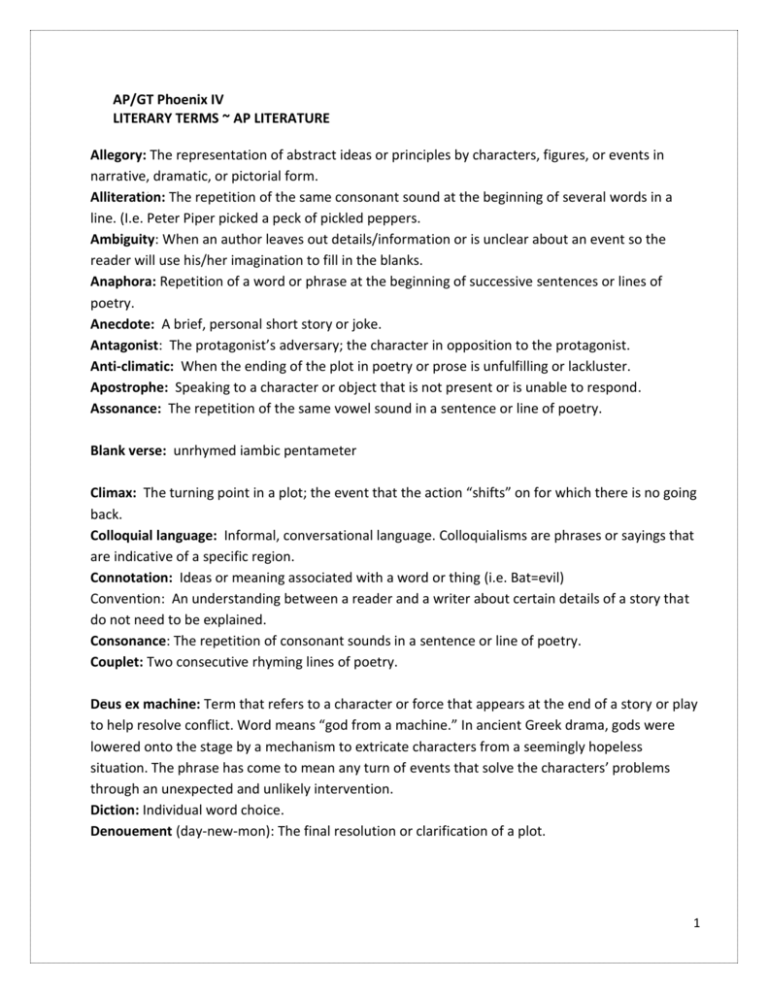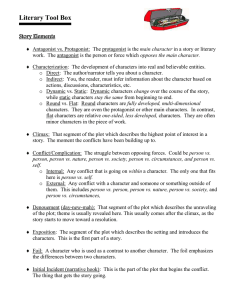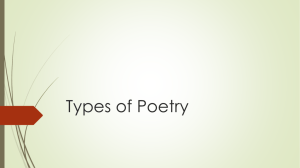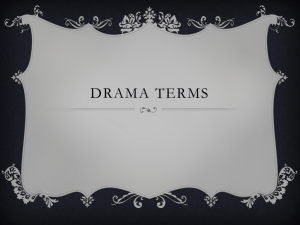AP/GT Phoenix IV LITERARY TERMS ~ AP LITERATURE Allegory
advertisement

AP/GT Phoenix IV LITERARY TERMS ~ AP LITERATURE Allegory: The representation of abstract ideas or principles by characters, figures, or events in narrative, dramatic, or pictorial form. Alliteration: The repetition of the same consonant sound at the beginning of several words in a line. (I.e. Peter Piper picked a peck of pickled peppers. Ambiguity: When an author leaves out details/information or is unclear about an event so the reader will use his/her imagination to fill in the blanks. Anaphora: Repetition of a word or phrase at the beginning of successive sentences or lines of poetry. Anecdote: A brief, personal short story or joke. Antagonist: The protagonist’s adversary; the character in opposition to the protagonist. Anti-climatic: When the ending of the plot in poetry or prose is unfulfilling or lackluster. Apostrophe: Speaking to a character or object that is not present or is unable to respond. Assonance: The repetition of the same vowel sound in a sentence or line of poetry. Blank verse: unrhymed iambic pentameter Climax: The turning point in a plot; the event that the action “shifts” on for which there is no going back. Colloquial language: Informal, conversational language. Colloquialisms are phrases or sayings that are indicative of a specific region. Connotation: Ideas or meaning associated with a word or thing (i.e. Bat=evil) Convention: An understanding between a reader and a writer about certain details of a story that do not need to be explained. Consonance: The repetition of consonant sounds in a sentence or line of poetry. Couplet: Two consecutive rhyming lines of poetry. Deus ex machine: Term that refers to a character or force that appears at the end of a story or play to help resolve conflict. Word means “god from a machine.” In ancient Greek drama, gods were lowered onto the stage by a mechanism to extricate characters from a seemingly hopeless situation. The phrase has come to mean any turn of events that solve the characters’ problems through an unexpected and unlikely intervention. Diction: Individual word choice. Denouement (day-new-mon): The final resolution or clarification of a plot. 1 Doppelganger: The alter ego of a character-the suppressed side of one’s personality that is usually unaccepted by society. (I.e. The Strange Case of Dr. Jekyll and Mr. Hyde by Robert Louis StevensonMr. Edward Hyde (hide) is Dr. Jekyll’s evil side.) Elegy: A poem or song composed especially as a lament for a deceased person. Enjambment: The continuation of reading one line of a poem to the next with no pause, a run-on line. Epic: An extended narrative poem in elevated or dignified language, celebrating the feats of a legendary or traditional hero. Epilogue: A short poem or speech spoken directly to the audience following the conclusion of a play or in a novel; it is a short explanation which indicates what happens after the plot ends. Epiphany: Sudden enlightenment or realization; a profound new outlook or understanding about the world usually attained while doing everyday mundane activities. Epistolary Fiction: A novel that tells its story through letters written by a character. Euphemism: The substituting of harsh, blunt, or offensive language bycomment for a more politically accepted or positive one. (short=vertically challenged) Euphony: A succession of words which are pleasing to the ear. These words may be alliterative, utilize consonance, or assonance and are often used in poetry but also seen in prose. Fable: A usually short narrative making a cautionary point; often employs animals that speak and act like humans. Figurative language: Speech or writing that departs from literal meaning in order to achieve a special effect or meaning; non-literal language. Speech or writing employing figures of speech. Flashback: When a character remembers a past event. Flat character: A character whose personality can be defined by one or two traits and does not change over the course of the story. Flat characters are usually minor or insignificant characters. Foil: A character that, by contrast, underscores or enhances the distinctive characteristics of another. Folklore: The traditional beliefs, myths, tales, and practices of a people, transmitted orally. Foot: The metrical length of a line of poetry is determined by the number of feet it contains. Every foot contains two beats. Monometer: One foot Dimeter: Two feet Trimeter: Three feet Tetrameter: Four feet Pentameter: Five feet Hexameter: Six feet Heptameter: Seven feet 2 Meter: The measured arrangement of words in poetry, as by accentual rhythm, syllabic quantity, or the number of syllables in a line. Iamb: An iambic foot has two syllables. The first is unstressed and the second is stressed. The iambic foot is most common in English poetry. Trochee: A trochaic foot has two syllables. The first is stressed and the second is unstressed. Dactyl: A dactylic foot has three syllables beginning with a stressed syllable; the other two unstressed. Anapest: An anapestic foot has three syllables. The first two are unstressed with the third stressed. Foreshadowing: Clues in the text about incidents that will occur later in the plot; foreshadowing helps create anticipation. Free verse: Poetry (verse) written in unrhymed iambic pentameter. Genre: A category of artistic composition, as in music or literature; marked by a distinctive style, form, or content. Gothic Novel: A genre of fiction characterized by mystery and supernatural horror; often set in a dark castle or other medieval setting. Heroine: A woman noted for courage and daring action; often the female protagonist. Hubris: Excessive human pride that usually leads to a hero’s downfall. Hyperbole: A figure of speech in which exaggeration is used for emphasis or comic/dramatic effect. Imagery: Vivid figurative language evoking the senses: visual, tactile, olfactory, auditory, gustatory. In medias res: A story that begins in the middle of things. Irony: When one thing should occur, is apparent, or in logical sequence but the opposite actuall occurs. Example: A man in the ocean might say, “Water, water everywhere and not a drop to drink.” Dramatic Irony: When the audience or reader knows something characters do not know. Verbal Irony: When one thing is said, but something else, usually the opposite, is meant. Cosmic Irony: When a higher power toys with human expectations. Memoir: An account of the personal experiences of an author. Metaphor: A figure of speech in which a word or phrase that ordinarily designates one thing is used to designate another, thus making an implicit comparison; this comparison does not use like or as. Metonymy: The use of a word or phrase to stand in for something else which it is often associated. I.e. Lamb means Jesus Motif: A recurring idea or item throughout a story. Novella: A short novel usually under 100 pages. Ode: A lyric poem of some length, usually of a serious or meditative nature and having an elevated style and formal stanzaic structure. An ode celebrates something. I.e. Ode to My Socks by Pablo Neruda 3 Onomatopoeia: Words such as buzz or murmur that imitate the sounds associated with the objects or actions they refer to. Paradox: A statement which seems to contradict itself. I.e. His old face was youthful when he heard the news. Parody: A literary or artistic work that imitates the characteristic style of an author or a work for comic effect or ridicule. I.e. SNL or Weird Al Yankovich. Personification: A figure of speech in which inanimate objects or abstractions are endowed with human qualities or are represented as possessing human form. Poetic justice: The rewarding of virtue and the punishment of vice in the resolution of a plot. The character, as they say, gets what he/she deserves. Point of View: First person: The narrator is a character in the story (“I”) Second person: The narrator tells a story on behalf of another (“you”) Third person objective: The narrator does not tell what anyone is thinking; the “fly on a wall” Third person limited: The narrator is able to tell the thoughts of one character. Third person omniscient: The narrator is able to tell the thoughts of all characters. Prologue: An introduction or preface, especially a poem recited to introduce a play. Prose: Ordinary speech or writing without metrical structure, written in paragraph form. Novels and short stories are referred to as prose. Protagonist: The character which the action of the story revolves around; the main character. Pun: A play on words, when two words have multiple meanings and spellings and are used in a humorous manner. Rhyme: Words or phrases that have the same sounds; the repetition of similar sounds. Rhyme scheme: The act of assigning letters in the alphabet to demonstrate the rhyming lines in a poem. Rising action: The events of a dramatic or narrative plot between the exposition and preceding the climax. Rite of passage: An incident which creates tremendous growth signifying a transition from adolescence to adulthood. Round character: A character who changes or develops over the course of a story. Resolution or Denouement: Solution to the conflict in literature; the tying up of loose ends. Satire: A work in which human vice or folly is attacked through irony, derision, or wit; the goal is to raise awareness or change the behavior/issue. Simile: A figure of speech in which two unlike things are compared, often in a phrase using like or as. Slang: Casual and playful speech deliberately used in place of standard terms for added raciness, humor, irreverence, or other effect. 4 Soliloquy: A dramatic form in which a character, alone on stage, talks to himself or herself and reveals his or her thoughts. Sonnet: A poem with fourteen lines, written in iambic pentameter, with a defined rhyme scheme. 2 types you should know: An Italian Sonnet divides into two quatrains and two tercets; an English Sonnet divides into three quatrains and one couplet. Style: The combination of distinctive features of literary or artistic expression, execution, or performance characterizing a particular person, group, school, or era. Symbolism: Something that represents something else by association, resemblance, or convention, especially a material object used to represent something invisible. Tragedy: A drama or literary work in which the main character is brought to ruin or suffers extreme sorrow, especially as a consequence of a tragic flaw, moral weakness, or inability to cope with unfavorable circumstances. Tone: Reflects how the author feels about the subject matter or the feeling the author wants to instill in the reader. 5





